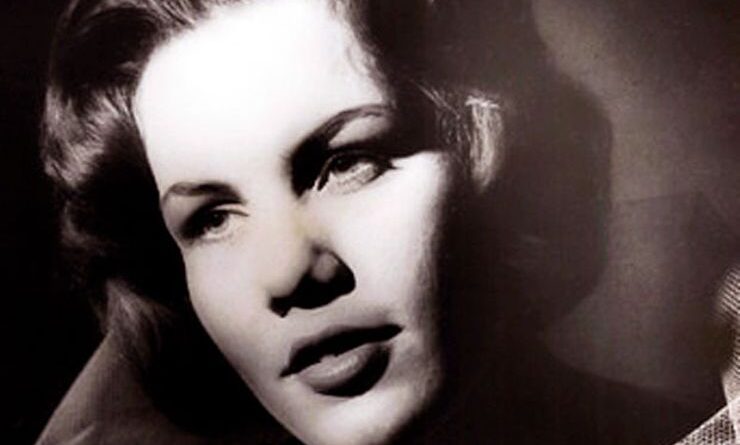Mary Shotwell Little Disappearance at Lenox Square Mall in Atlanta Georgia
On October 14, 1965, Mary Shotwell Little, a young bank secretary, vanished without a trace from Lenox Square Mall in Atlanta, Georgia. This chilling case has puzzled law enforcement, sparked widespread media attention, and left the public in suspense for decades. With no definitive answers even after extensive investigations, the disappearance of Mary Shotwell Little remains one of Atlanta’s most notorious unsolved mysteries.
A Normal Day Takes a Dark Turn
Mary Shotwell Little, a 25-year-old woman, had only been married to her husband, Roy Little, for six weeks when she went missing. On the day of her disappearance, everything seemed normal. She worked her shift at Citizens & Southern National Bank and planned to meet friends for a casual dinner at Lenox Square Mall afterward. Mary’s co-workers recalled her being in good spirits that day. However, later that evening, her life took a dark and unexplained turn.
After finishing her meal, Mary walked back to her car, a 1965 Mercury Comet, in the mall’s parking lot. What happened next remains a complete mystery. By the following morning, Mary was gone. Her car, however, was found still parked at the mall—eerily suggesting something had gone terribly wrong between the time she left the restaurant and the early hours of the next day.
The Frantic Search Begins
When Mary failed to show up for work the following day, her colleagues grew concerned and alerted authorities. Atlanta police were quick to respond, combing the area around Lenox Square Mall. The initial search uncovered alarming clues. Mary’s car was still in the parking lot, but it wasn’t just sitting idly. Inside, officers found unsettling evidence: bloodstains were present on the driver’s seat, and her undergarments were discovered inside the vehicle. Even more baffling, her gas tank had been recently refueled, despite no clear explanation of how or when that happened.
Adding to the eerie nature of the scene, the windows of her car were wiped clean of fingerprints. These early clues pointed to the possibility of foul play, but there were no concrete answers to provide any closure for Mary’s family or investigators.
The Investigation Unfolds
The Atlanta Police Department launched a massive investigation, but from the start, they faced significant challenges. While some initial leads came in, including alleged sightings of Mary and possible suspects, they all led to dead ends. No one saw what happened to Mary that night at the mall, and the evidence left behind raised more questions than answers.
Investigators interviewed Mary’s husband, Roy Little, her family, friends, and co-workers. Roy had been away on business in North Carolina at the time of her disappearance, which ruled him out as a suspect, at least initially. However, authorities soon started digging deeper into Mary’s personal life, uncovering strange and conflicting details. Some suggested that Mary had been dealing with personal struggles, though nothing surfaced that would clearly explain her vanishing.
Unusual Clues and Speculation
The most perplexing clues in the case were the bloodstains found in Mary’s car and the fact that it had been refueled after her disappearance. Some speculated that Mary might have been abducted and held somewhere before her car was driven back to Lenox Square Mall. However, this theory never produced any hard evidence.
Further complicating matters, her vehicle appeared undisturbed on the outside. This odd combination of factors—a spotless exterior, blood inside, and no immediate signs of struggle—left investigators stumped. The wiped-down windows suggested someone went to great lengths to erase any traces of what had occurred, leading many to believe the abductor had a well-thought-out plan.
Mary’s Personal Life: Clues or Coincidence?
As the investigation progressed, Mary’s personal life came under intense scrutiny. Though she was happily married to Roy Little, some reports hinted at potential problems in her life that could have played a role in her disappearance. There were whispers that Mary had confided in friends about an unknown man who had been harassing her. Additionally, there were suggestions that her marriage wasn’t as stable as it seemed on the surface.
However, these claims were never substantiated, leaving investigators to wonder whether they were merely coincidental or critical clues. Another theory posited that someone close to her, perhaps even someone she knew well, could have been responsible for her disappearance. But again, no solid evidence backed this up, and the case grew colder as the weeks turned into months.
Sightings of Mary Shotwell Little After Her Disappearance
Charlotte, North Carolina
Shortly after Mary Shotwell Little went missing, two separate gas station attendants in Charlotte reported seeing a woman who appeared to be in distress. These sightings occurred on the night of October 15, 1965, just a day after Mary was last seen in Atlanta.
According to the attendants, the woman bore a striking resemblance to Mary and seemed to be accompanied by two men. Her appearance raised concerns: she was described as having bruises on her face and body, and she seemed visibly upset. One attendant mentioned that the woman appeared to be coerced, noting that she seemed fearful of the men who were with her. She allegedly remained quiet and did not speak much during the encounters, further fueling suspicions that something was wrong.
Witnesses recalled that the men were controlling the situation, paying for gas and refueling the car, while the woman stayed in the vehicle. The attendants tried to make small talk, but the woman offered only brief, nervous responses. The description of the car matched Mary’s 1965 Mercury Comet, which had already been found in Atlanta. These details sparked interest from investigators, but with little more to go on, no leads emerged from the sighting.
Raleigh, North Carolina
The following day, on October 16, another sighting of a woman who resembled Mary was reported at a gas station in Raleigh, North Carolina. Similar to the Charlotte sighting, the woman was described as looking frightened and possibly injured. The gas station attendant in Raleigh recalled that the woman was again accompanied by two men, who appeared to be controlling her movements.
The attendant reported that the woman had bruises and seemed desperate. Like the Charlotte sighting, the car was noted to match the make and model of Mary Shotwell Little’s vehicle. Although there were attempts to engage with the woman, she remained silent or offered vague answers, and the men quickly ended any interaction, fueling suspicions that she was being held against her will.
Both sightings in North Carolina generated significant interest from law enforcement, and investigators explored the possibility that Mary had been abducted and taken across state lines. These reports lent credence to the theory that she might have been forcibly removed from Atlanta after leaving the mall, potentially by individuals who were holding her captive.
Disturbing Similarities Between the Sightings
The common details between the Charlotte and Raleigh sightings were striking. In both instances, the woman was seen in the company of men who seemed to be dominating her, and in both cases, she appeared physically harmed. These details painted a distressing picture of a woman in peril, heightening fears that Mary might have been the victim of a violent abduction.
Additionally, the timing of the sightings—within days of her disappearance—made it seem plausible that the woman was indeed Mary Shotwell Little. The fact that she was seen in two different North Carolina cities fueled speculation that her abductors might have been transporting her through the state, possibly in an effort to evade detection.
Challenges in Verifying the Sightings
Despite the compelling nature of these reports, investigators were unable to definitively prove that the woman seen at the gas stations was Mary Shotwell Little. None of the witnesses could positively identify her beyond noting her resemblance to Mary, and there were no other concrete pieces of evidence linking the sightings to her disappearance.
Moreover, investigators found it difficult to reconcile the fact that her car had been found in Atlanta with reports of it being seen hundreds of miles away in North Carolina. It raised questions about how and when her car was returned to Lenox Square Mall, and whether the woman seen in North Carolina was truly Mary.
Without further corroboration, the sightings remained tantalizing but inconclusive pieces of the puzzle. Law enforcement continued to pursue these leads, but they ultimately proved to be dead ends.
The Murder of Diane Shields and Its Connection to Mary Shotwell Little’s Disappearance
Two years after Mary Shotwell Little vanished from Lenox Square Mall in Atlanta, another unsettling crime shocked the city—a young woman named Diane Shields was found murdered under mysterious circumstances. What made this crime even more disturbing was its eerie connection to Mary’s unsolved disappearance. Both women had worked at the same bank, and some believed Diane was looking into Mary’s case at the time of her death. While there is no conclusive proof linking the two cases, the chilling similarities and unanswered questions have fueled speculation for decades.
Diane Shields: A Rising Star with a Promising Future
Diane Shields was a 22-year-old woman living in Atlanta, Georgia, when her life was cut tragically short. Known for her outgoing personality and ambition, Diane had recently taken on a clerical job at Citizens & Southern National Bank, where Mary Shotwell Little had also worked before her disappearance in 1965. While the two women didn’t overlap in their employment at the bank, their association with the same workplace, along with the strange circumstances of both cases, has long intrigued investigators and crime enthusiasts.
Diane’s life appeared to be moving in a positive direction. She had recently announced her engagement, and by all accounts, she seemed happy and focused on her future. However, whatever plans she had were tragically interrupted in 1967 when she was found murdered in her car—just two years after Mary’s unexplained vanishing.
The Discovery of Diane’s Body
On the night of May 19, 1967, Diane Shields left work at the bank as usual. She was last seen driving away in her car, a 1963 Chevrolet Impala, on her way home. When she failed to return, friends and family grew concerned. Hours later, her body was found in the trunk of her own car, parked at a carwash on Sylvan Road in southwest Atlanta.
Diane had been suffocated to death. A cloth had been stuffed into her mouth, and her hands were clasped together as if she had been praying, a haunting detail that raised many questions about the killer’s motives. There were no signs of sexual assault, and her purse and other belongings were left untouched, ruling out robbery as a motive. Her vehicle’s exterior was also clean, suggesting that her killer had taken the time to ensure no evidence was left behind, much like in the case of Mary’s meticulously wiped-down car.
Theories About the Connection Between Diane Shields and Mary Shotwell Little
The murder of Diane Shields stirred memories of Mary Shotwell Little’s disappearance, which remained unsolved. Both women were young, attractive, and worked at the same bank, leading many to wonder if the two cases could be connected. While the specifics of Diane’s murder were different from Mary’s disappearance, the timing, the location, and the shared workplace led to intense speculation.
One of the most prominent theories was that Diane Shields had been investigating Mary’s disappearance on her own and had uncovered something dangerous in the process. According to this theory, Diane’s murder was an act of retaliation, carried out to silence her before she could reveal any new information. There were reports that Diane had taken an interest in Mary’s case, though this has never been definitively proven.
Proponents of this theory point to the manner in which Diane was killed. The fact that her hands were clasped as if in prayer has led some to speculate that the murder had symbolic meaning, possibly a warning to others who might have been looking into Mary’s disappearance. The lack of a sexual assault or robbery further suggests that Diane’s murder was premeditated and personal, rather than a random act of violence.
Unsolved and Haunting
To this day, both the disappearance of Mary Shotwell Little and the murder of Diane Shields remain unsolved, casting a long shadow over Atlanta’s criminal history. The potential connection between the two cases has sparked decades of speculation, but no concrete links have been found. Despite renewed interest in both cases over the years, investigators have not uncovered the necessary evidence to bring either case to a close.
The lack of answers continues to haunt those who remember the cases. Mary’s disappearance remains one of Atlanta’s most enduring mysteries, while Diane’s murder is a stark reminder of the dangers that young women faced in the 1960s—and continue to face today. Whether the two cases are connected or not, they share the same tragic fate: both women’s stories ended abruptly, leaving behind only questions and heartache for their families and loved ones.
Theories and Speculation
The disappearance of Mary Shotwell Little from Lenox Square Mall in Atlanta on October 14, 1965, has been the subject of numerous theories and speculation. Despite extensive investigations, law enforcement and amateur sleuths alike have been unable to definitively solve the mystery of what happened to her that night. Over the years, various ideas have emerged, ranging from theories about personal struggles to potential foul play by unknown assailants. Below, we explore some of the most prominent theories and the speculation that has surrounded Mary’s case.
Abduction by a Stranger
One of the most widely accepted theories is that Mary Shotwell Little was abducted by a stranger in the parking lot of Lenox Square Mall. This theory hinges on the fact that her car was found with bloodstains inside and signs of a possible struggle, such as her undergarments being left in the vehicle. Additionally, her car had been mysteriously refueled after her disappearance, suggesting that someone had driven it after she went missing. These details point to the possibility that Mary was abducted shortly after returning to her car and that her kidnapper took her elsewhere before returning the vehicle to the parking lot.
Some theorists believe that Mary may have been the victim of a random act of violence or opportunistic crime. Lenox Square Mall, though a popular shopping destination, had large, dimly lit parking areas where someone could have easily gone unnoticed. The abductor may have approached Mary as she entered her car, overpowering her and taking control of the vehicle. This would explain the refueled car and the bloodstains, though it leaves many questions unanswered, such as why no one heard or saw anything unusual that night.
While this theory fits the available evidence, it struggles to explain certain aspects of the case, including the sightings of a woman resembling Mary in North Carolina. These sightings suggest that she may have been alive in the days following her disappearance, casting doubt on the idea that her abduction was a quick and violent act in the parking lot.
A Targeted Attack
Another theory posits that Mary was not the victim of a random crime but was specifically targeted by someone she knew. This theory has gained traction due to several unusual details about her personal life that surfaced during the investigation. While her marriage to Roy Little appeared to be happy, some reports indicated that Mary had confided in friends about feeling uneasy and receiving unwanted attention from a man. There were also whispers that her marriage may not have been as stable as it seemed on the surface, leading to speculation that someone close to her might have had a motive to harm her.
One version of this theory suggests that Mary was being stalked or harassed by an unknown man, and that this individual followed her to the mall that night. The bloodstains in her car could indicate that a struggle ensued between Mary and her attacker. The fact that the windows of her car were wiped clean suggests that the perpetrator took great care to cover their tracks, which could indicate premeditation.
However, there is no concrete evidence to support this theory. No one came forward to identify a specific individual who may have been stalking Mary, and her friends and family were unable to point to any obvious suspects. Investigators also looked into her husband, Roy Little, but he was in North Carolina on a business trip at the time of her disappearance, making it unlikely that he was directly involved.
Theories Involving Mary’s Personal Life
As with many missing person cases, Mary’s personal life became a focal point of speculation. Investigators discovered that in the weeks leading up to her disappearance, Mary had made several unusual comments to friends and colleagues. Some reports suggest that she had expressed fear of an unidentified man who had been bothering her. Others indicate that Mary may have been dealing with personal stress or emotional difficulties in her life.
These revelations led to speculation that Mary may have left of her own accord. Some theorists believe she may have staged her disappearance to escape a troubled relationship or start a new life elsewhere. The fact that no ransom note or demand for money was ever made in her case supports the idea that financial gain was not a motive, making a voluntary disappearance seem more plausible to some.
However, this theory struggles to explain the physical evidence found at the scene, including the bloodstains in her car and the suspicious activity involving her vehicle after her disappearance. The sightings of a woman resembling Mary in North Carolina, who appeared bruised and distressed, further complicate this theory. If Mary had voluntarily left Atlanta, it seems unlikely that she would have been seen in such a state of distress. Additionally, Mary’s family and friends consistently maintained that she had no reason to run away, especially after only six weeks of marriage.
The Connection to Diane Shields
In a strange twist, another young woman, Diane Shields, who had briefly worked at the same bank as Mary, was murdered in Atlanta two years after Mary’s disappearance. Diane’s murder, which remains unsolved, led some to speculate that the two cases might be connected. Diane had reportedly been looking into Mary’s case before she was killed, leading some to wonder if she uncovered information that put her in danger.
This theory suggests that Mary’s disappearance was part of a broader, more sinister plot, possibly involving someone connected to both women. Some believe that Mary and Diane were targeted because of something they knew or were involved in, though no evidence has ever surfaced to prove this connection. Diane’s murder remains as perplexing as Mary’s disappearance, and while the timing and circumstances are suggestive, there is no definitive link between the two cases.
The North Carolina Sightings
A particularly intriguing aspect of the case is the reported sightings of Mary Shotwell Little at gas stations in Charlotte and Raleigh, North Carolina, in the days following her disappearance. In both instances, witnesses described seeing a woman who resembled Mary, appearing bruised, distressed, and in the company of men who seemed to be controlling her.
These sightings lend credence to the theory that Mary was abducted and transported out of Atlanta, possibly by a group of individuals who intended to keep her captive. The fact that the woman seen in North Carolina matched Mary’s description and was reportedly in poor condition suggests that she may have been harmed and unable to escape.
However, the sightings remain unverified, and it is possible that the woman seen at the gas stations was not Mary at all. The descriptions given by the witnesses, while compelling, were not definitive, and no physical evidence has been found to corroborate the claims. Still, these reports continue to fuel speculation that Mary may have been taken across state lines after her disappearance.
Foul Play by Organized Crime
Another less prominent theory is that Mary may have been the victim of foul play involving organized crime. In the 1960s, Atlanta, like many large cities, had its share of criminal activity, including mafia involvement. Some have speculated that Mary could have witnessed something she wasn’t supposed to see or was inadvertently caught up in illegal activities.
While there is no direct evidence to support this theory, it offers a possible explanation for the strange circumstances surrounding her car, such as the fact that it was refueled and its windows wiped clean. The meticulous nature of these details suggests that her abductor—or abductors—were careful to avoid detection, a hallmark of organized crime.
However, without any clear links between Mary and such criminal elements, this theory remains largely speculative.
A Cold Case That Haunts Atlanta
Despite the initial flurry of activity in the weeks following her disappearance, the trail eventually went cold. Over the decades, the case has been periodically revisited, but no new evidence has ever come to light. The unanswered questions continue to haunt the city of Atlanta, where Mary’s disappearance remains one of the most perplexing cases in the region’s history.
The story of Mary Shotwell Little’s disappearance touches on many emotions: grief, fear, confusion, and frustration. Her case remains unsolved, and her fate continues to be a topic of speculation among true crime enthusiasts, amateur sleuths, and those who still remember the events of that fateful night in 1965.
The Legacy of a Vanishing
For the family and friends of Mary Shotwell Little, her disappearance was nothing short of a tragedy, a chapter that remains open even after nearly six decades. The lack of closure, the absence of answers, and the ongoing questions surrounding her case are a sobering reminder of how some mysteries resist resolution. Her case underscores the complexity of missing person cases and highlights the challenges law enforcement faces in solving such intricate puzzles.
Despite the exhaustive efforts of the police, the case remains unsolved, locked away as a cold case that might never see resolution. Yet, Mary Shotwell Little’s story endures as a piece of Atlanta’s history, her name forever linked to the unanswered questions of what happened on that dark night at Lenox Square Mall.
Discover more from City Towner
Subscribe to get the latest posts sent to your email.




